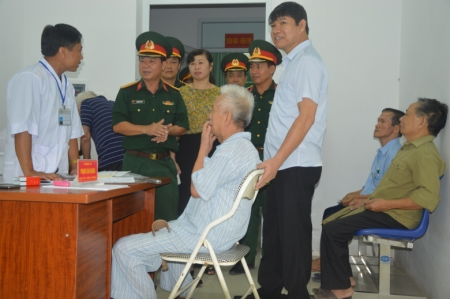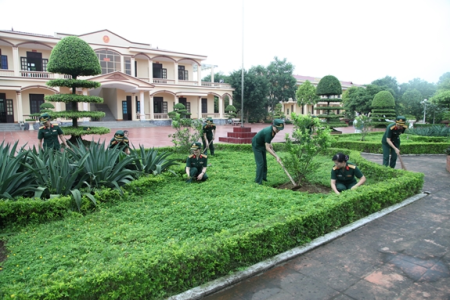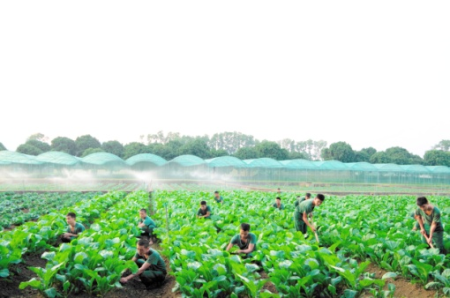Over the years, the Army Corps 1’s Logistics Branch has synchronously taken ideological, organisational, and professional measures for well performing the logistics work. Grounded on the Central Military Commission’s Resolution 623-NQ/QUTW on “the Military’s logistics work towards 2020 and beyond,” on July 5th 2013, the Corps’ Logistics Department formulated the Plan 560/KH-CHC to concretise the basics, goals, and targets of the Resolution in accordance with the Corps’ particularities and tasks. In the Plan, the Logistics Department set a breakthrough in raising the quality of routine logistics support and ensuring troops’ life and fitness in order that the Corps would be capable of training, combat readiness, and all assigned missions.
 |
| Sr. Col. Nguyen Huy Dung inspecting the work of medical examination and treatment at a clinic of the Corps |
To realise that breakthrough, the Logistics Department has proactively advised the Corps’ Party Committee and Command on directing affiliated units to enhance leadership over the logistics work and engage a large number of their cadres and soldiers in this work. Party committees and commands of the affiliated units have developed plans and supplemented sectors’ regulations on leadership, management, and use, actively renewed the method of providing logistics materials under the new financial management mechanism, further decentralised logistics support, and expanded bidding in acquisition under the regulations. At the same time, the Department has advised the all-level party committees and commands on stepping up the emulation movement entitled “the Military Logistics Branch follows Uncle Ho’s teachings” and setting and multiplying typical examples. Thanks to sound directions and proper measures, the Corps’ logistics work has made considerable, stable progress. The regulations on the logistics work from offices to units have been strictly maintained. There have been many reforms in logistics support to be relevant to the Military’s new financial management mechanism. The Logistics Branch has provided timely, sufficient logistics support for units tasked with training, combat readiness, natural disaster prevention and mitigation, and other contingency missions.
To meet the increasingly higher requirements set by logistics support and deal with difficulties caused by constant fluctuations in food price, climate, and epidemics, the Corps’ Logistics Department has taken various measures for stabilising and improving troops’ life and fitness. To that end, the Corps has enhanced the decentralisation of logistics support for its affiliates, closely combined the decentralisation of logistics support with the work of inspection and supervision, and encouraged its units to proactively exploit sources of food at the convenient times, promote the bright side of the market mechanism and the strength of their stationed areas, and raise the effectiveness of creating sources of food. The Corps’ Logistics Department has also directed the military supplies sector to actively cooperate with financial agencies and price councils in closely appraising and supervising units’ bidding and acquisition to ensure the high quality and reasonable price of food used by their messes.
 |
| The Political Department’s staff members making contributions to building regular, green, clean and scenic barracks |
In addition, the Corps has attached great value to stepping up animal and crop husbandry as a key measure for providing a stable source of healthy food so as to improve its troops’ meals and create its units’ revenue stream. To do so, the Logistics Department has counselled and enhanced its leadership over animal and crop husbandry, develop long-term and annual plans for this work, and clearly set out the mechanisms, methods, and targets of animal and crop husbandry in accordance with each type of units and each area’s particularities. Under the Corps’ direction, units have actively promoted their internal strength, exploited and upgraded lands and ponds to make plans for animal and crop husbandry in line with the building of “regular, green, clean, scenic” barracks, while managing and protecting the national defence land and environment in a focalised, sustainable, closed manner. In this regard, a focus has been placed on developing the “five-basic” model (garden, pond, barn, pergola, and processing station) and realising three breakthroughs in raising breeding pigs and fish and developing pergolas. In addition to maintaining traditional models of animal and crop husbandry, the Corps has made investments in constructing and multiplying various new models, diversified livestock and crops, and applied the VietGap standards and modern technologies to animal and crop husbandry. To improve the efficiency of animal and crop husbandry, the Logistics Department has directed units to use new types of crops and livestock, with priority given to planting high-quality crops and vegetables which could be preserved and reserved for a long time. To increase the quantity of fruits, the Corps has asked its units to produce more fruits, such as banana, pomelo, and pineapple. Since 2017, troops’ meals have been included fruits produced by the Corps’ units.
 |
| A vegetable garden of the Regiment 102 under the Division 308 |
Moreover, the Corps has directed its units to develop animal husbandry in a semi-industrial form and focus on raising super-lean pigs and fish and gradually developing cattle in order to diversify and improve their troops’ rations. It should be noted that the Corps has rapidly developed and raised a herd of breeding pigs under a closed model. In response to the outbreak of African swine fever, the Logistics Department has directed units to keep a close eye on the epidemic, adopt measures for disease localisation, sterlisation, and prevention, closely control sources of food and infection for pigs, restrict the development of the herd of pigs, and foster poultry farming. By adopting drastic and proper measures, the Corps has managed to prevent its herd of pigs from being infected with the disease. Despite a decrease in the number of pigs, the quality of its troops’ meals has been maintained, thanks to its poultry farming. Up to now, the Corps has had 13 zones for animal and crop husbandry at the regimental level, with hundreds of hectares of garden and fish pond, hundreds of thousands of square metres of barn and pergola, hundreds of pigsties, and tens of thousands of chickens and ducks. Thanks to its development of animal and crop husbandry, the Corps has been 100% self-sufficient in vegetable, meat, and egg and 80%-85% self-sufficient in fish, with good quality and hygiene, thereby making great contributions to stabilising and improving its troops’ life even when the price of these foods has sharply increased.
The work of ensuring troops’ meals has been closely directed by the Corps’ Logistics Department. The all-level logistics offices have enhanced management and inspection of troops’ meal quality and allowance, and closely supervised the quality and price of foods of all types at messes. Units within the Corps have employed various measures for improving troops’ dishes and combined animal and crop husbandry development with the raised effectiveness of processing stations and slaughterhouses for the sake of a closed process from production to use. At the same time, due attention has been paid to stepping up unexpected and cross inspections of messes. As a result, the quality and hygiene of troops’ meals have been maintained. To meet the requirements for feeding its troops, the Corps has invested billions of VND in modernising and standardising equipment of messes so that units could provide their troops with meals in barracks and during field trips. Besides, the Corps has installed 108 inox basins and 120 freezers at its messes, provided nearly 600 water filters for its affiliated units, and set up and effectively used 103 boilers, thereby improving the logistics force’ working conditions and raising the quality of troops’ meals.
Due regard has been paid to ensuring troops’ accommodations and living conditions by the Corps’ Logistics Branch. Units within the Corps have stepped up the emulation movement entitled “building and managing regular, green, clean, and scenic barracks.” The work of capital construction has been carried out in accordance with the regulations and procedures, with the high quality and efficiency. The Corps’ units have actively repaired and upgraded their facilities, with priority given to accommodations, messes, toilets, water supply system, and bathrooms equipped with water heaters. They have also actively promoted their internal strength and troops’ labour to consolidate barracks and construct the system of yards, internal roads, and flower and bonsai gardens in order to create bright, green, clean, and scenic surroundings and considerably improve their troops’ living conditions.
Additionally, the Corps’ Logistics Department has focused on directing troops’ health care and protection. Over the years, the Corps has attached great value to raising the quality of troops’ health care and protection at grass-roots level. The military health system from the Corps to unit level has been consolidated and provided with sufficient equipment to meet the requirements for each level’s medical examination and treatment. The work of propagation on hygiene, epidemic prevention and control, and food safety has been conducted regularly and helped shape troops’ hygienic and scientific lifestyle. Troops’ health has been closely, systematically managed. Up to now, all cadres and soldiers within the Corps have been provided with health records and medically examined on a yearly basis at each level. As a result, all affiliates of the Corps have satisfied the criteria of “five-good military medical unit” while the Corps’ rate of healthy soldiers has always been nearly 99%.
The above-mentioned achievements will be an incentive for the Army Corps 1’s Logistics Brach to continue further improving the quality and effectiveness of logistics support in order to greatly contribute to enhancing the Corps’s combat power and making the Corps comprehensively strong and capable of fulfilling all assigned missions.
Sr. Col. Nguyen Huy Dung, Director of the Army Corps 1’s Logistics Department